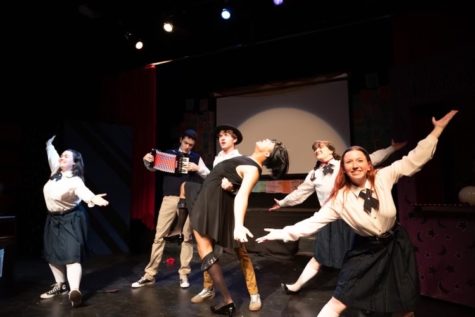Ups, downs of TUPAS’ ‘Ride the Cyclone’
May 8, 2023
By now, Tulane University students have entered a period of limbo in the academic year, a disorienting space between the end of classes and the start of summer.
In this sense, the Tulane University Performing Arts Society’s production of “Ride the Cyclone” is quite timely. The characters of this quirky cult musical — six members of a school choir from Uranium City, Saskatchewan — find themselves in a literal purgatory after being thrown off the rickety “Cyclone” roller coaster. The presider of the fairground’s netherworld and the emcee of the night’s events is the Amazing Karnak, a wry and sometimes sinister mechanical fortune teller. At the very start of the play, the Amazing Karnak sets the stage for the play’s intrigue, informing the six kids that only one of them will return to the mortal realm, with that person being chosen via a unanimous vote. The rest of the play consists of each character pleading their case — all in song, of course.

The score is pastiche-y, composed of both operatic arias alongside pop anthems. The cheekiness of the songs, despite their varied genres, is what allows for the play’s cohesiveness. Each character’s number provides a glimpse into their often troubled backstories and renders them as one of the teenage archetypes à la John Hughes’ “The Breakfast Club.” Curiously, there is one character, the unnervingly doll-like Jane Doe, who no one knows and who has no history to speak of. The mystery of this character’s identity is another element feeding the play’s suspense.
Mainly, it is the momentum generated by the play’s endless twisting and turning that pulls the audience along. At the end, you are left feeling dizzy and, hopefully, satisfied.
It is both very hard and very easy to describe “Ride the Cyclone.” On the one hand, it is tragic and funny, gritty and lighthearted, unsettling and thrilling. On the other, it is like so many shows that seek to appeal to Generation Z audiences with cheap absurdity, filling themselves with non sequiturs, unexplained actions and dark jokes. What makes this kind of show strange is exactly what, nowadays, makes it familiar. When you laugh, it’s probably that particular type of laugh where you mutter “What?” while shaking your head, as if at a meme a friend is eagerly showing you on their phone.
Beneath its insistence that “not every story has a lesson,” the play is really an affirmation of life’s joy — an unsurprising theme for a musical. This kind of joy, as is strongly suggested, is something like the mix of terror and delight one feels riding a roller coaster. Considering the fact that the play takes place in the space of death, its mirroring of the “roller coaster of life,” with its sudden plot twists and emotional highs and lows, is thoroughly ironic. This irony, so characteristic of Gen Z humor, extends to nearly all other aspects of the show. There are cats with laser beams, if that tells you anything.
Although it is not until the end that nihilism is overcome and the emotional core of the show is revealed, it is hinted at throughout. As each character takes the stage for their solo number, a slide containing real pictures of them from various eras of life is projected behind them, conjuring up a warm nostalgia within audience members about their own lives. You are suddenly made aware of your place, sitting in a theater and bemused at all of the strange events that led you there. Even though I planned on attending the performance, I somehow felt that I had just happened upon it and stayed on a whim. That feeling is, to my mind, a sign of this production’s success in spite of the shortcomings of the play itself.
TUPAS also pulled off the technical aspects of the production well, especially considering that it was entirely student-run. Sound cues and media projections were prominently featured and seamlessly executed, even for a dress rehearsal. Quick costume changes — including the reveal of a slip dress beneath a choir boy outfit in one case, and knee-high pink boots and cosmic-colored running shorts in another — also went off without a hitch.
The ensemble cast was equally cohesive, both emotionally and vocally. The score allowed soloists some impressive vocal stunts and the harmonies of the backing quintet were consistently tight. Most importantly, the shared playfulness among the actors radiated out towards the audience; it was clear they trusted each other and were willing to take comedic risks. In those moments, the play transcended its shallow absurdity and realized itself as downright campy, which I actually preferred.
TUPAS’ production of “Ride the Cyclone” closed out this year’s theater performances not with a crash, but with a bang. It was a wild ride, but one that I would ride again.






















Leave a Comment